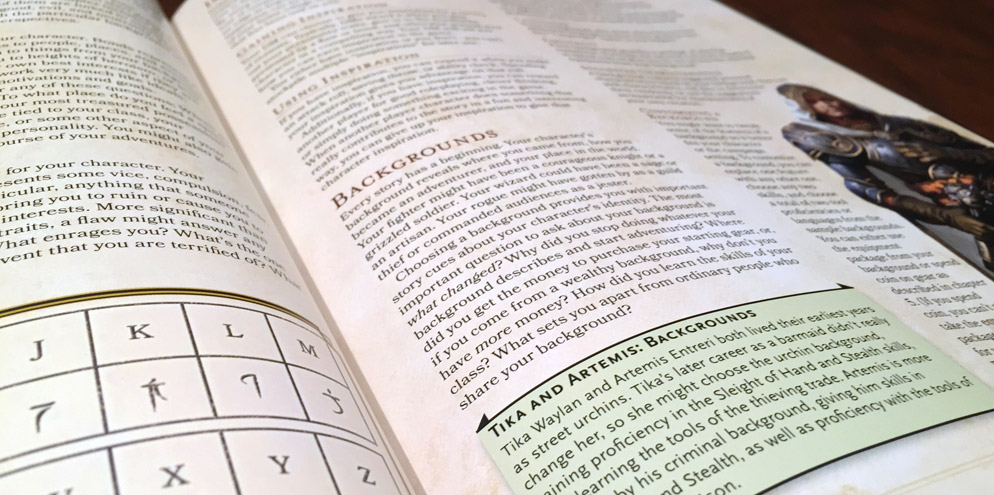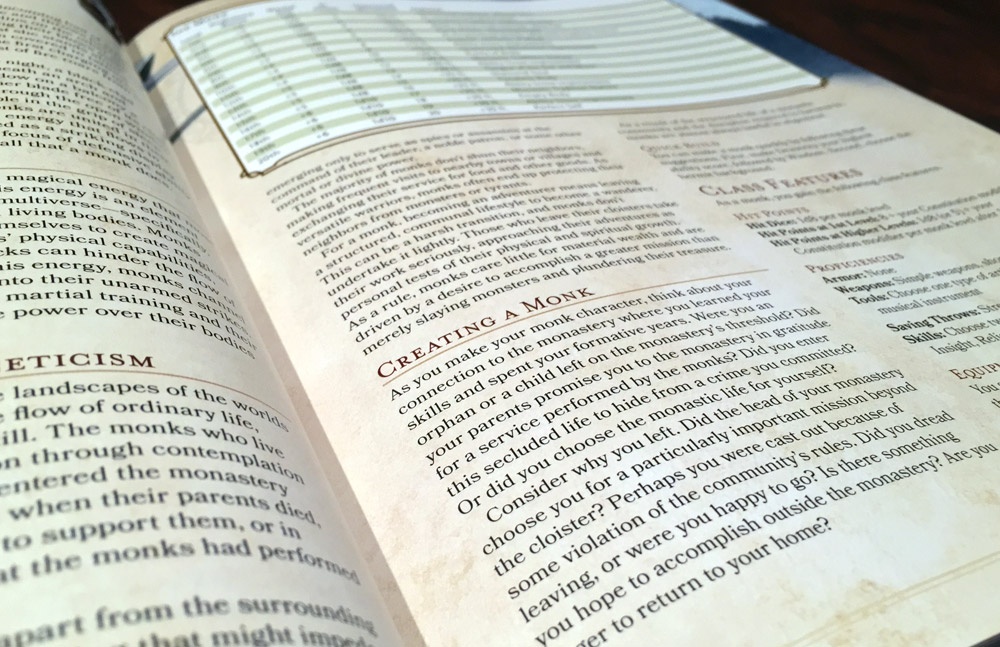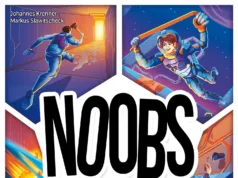 I’ll wager that you don’t have to be much of a gamer to have heard of Dungeons and Dragons. Whether you heard about this role playing game (RPG) from pop culture references on TV, from an absurdly humorous pamphlet handed to you in the 80s, or just as a gamer yourself, Dungeons and Dragons (DnD) has long since been a staple on our gaming tabletops.
I’ll wager that you don’t have to be much of a gamer to have heard of Dungeons and Dragons. Whether you heard about this role playing game (RPG) from pop culture references on TV, from an absurdly humorous pamphlet handed to you in the 80s, or just as a gamer yourself, Dungeons and Dragons (DnD) has long since been a staple on our gaming tabletops.
At Gen Con 2014, publisher Wizards of the Coast (WotC) released the 5th edition of this tabletop staple after more than a year of open play testing. In 2007, Wizards of the Coast released what was probably the most polarizing edition of their flagship RPG, DnD’s 4th Edition. Reviews of this edition ranged from “I love it” to “Wizards has destroyed a legacy”. Regardless of how you felt about the edition, no one can argue that the edition was a perfect RPG. Characters all felt very similar, upper level battles could take extremely long, and to play the game it was required to use a grid (battle mat). I’m guessing that this edition didn’t have the legs that WotC was hoping.
 Enter 2014. After much play testing, DnD Next (as it was called during the playtest period) has finally been published and delivered to eager gamers everywhere. Now simply titled Dungeons and Dragons, is this latest edition enough to bring gamers back into the fold who may have left the dragons nest? Let’s find out as we dive into the 5th edition of Dungeons and Dragons.
Enter 2014. After much play testing, DnD Next (as it was called during the playtest period) has finally been published and delivered to eager gamers everywhere. Now simply titled Dungeons and Dragons, is this latest edition enough to bring gamers back into the fold who may have left the dragons nest? Let’s find out as we dive into the 5th edition of Dungeons and Dragons.
This review will follow a bit of a different path then our normal tabletop review. There won’t be any sections on components or how to play since the product you are buying is essentially a rulebook itself. Instead, I’ll dive into what’s new, what I like and my thoughts on this new edition. I was originally going to review the whole game (the three core rulebooks) in one review, but it was going to be way too long. So I’ll be breaking the review up by book, starting with the Player’s Handbook (then onto the Monster Manual and Dungeon Masters Guide). That’s probably the best way to do it anyway. No one wants to read a 4,000 word review.
Having played every edition of DnD since my very first basic box as a kid, I was pretty excited to see what the new edition had in store for us. My biggest hope was that they could fix the things that polarized gamers from 4th edition, while not going back to the flaws that muddled up the 3rd edition. Let’s find out!
Dungeons & Dragons Fifth Edition Player’s Handbook
The Player’s Handbook (PHB) clocks in at over 300 pages and it stuffed to the brim with rules, charts, tables, and artwork befitting a RPG core book. Reading through it, if I had to pick one word to sum up this new edition, I’d have to go with: “Streamlined”. From character creation, to combat, to rolling dice; everything has been crafted to make your games flow smoother and quicker.
On Character Creation
Character creation is as easy as it’s ever been. All the classes you’d expect to see are present, along with the usual level progression charts and descriptions. From the iconic (fighter, rogue, cleric, wizard) to the more fringe classes (monk, warlock), you’d be hard pressed to find a class you don’t want to try. Creating a character is as quick as choosing a race (all the usual aspects are here), choosing a class, and rolling your scores. One of the nice things about character creation is the new background rules.
With backgrounds, players are given options for their character that help them craft back story. Not only do they get some bonuses and equipment (to draw the interest of min/maxers), but it also helps define what your character was doing before he started adventuring. It also can provide a hook for a Dungeon Master (DM) to draw some role playing out of new players. Even for those of us that aren’t the greatest of writers, we can roll on a few charts and come up with a unique history for our characters. I thought this was a great idea as I’ve played with many players that didn’t put more than two thoughts into a background. It makes for a much more enriching play experience when a DM can weave a story that mixes in elements from a player’s history.
To go along with this, DMs can now give out Inspiration. These are small little bonuses that can be granted to players for role playing their character creatively, acting within their alignment (yes its back), or staying true to their flaws (some characters will have them). Once granted Inspiration, a player can cash it in to gain the system’s newest mechanic, Advantage.
On Combat
 Well get into the advantage/disadvantage mechanic in a second, but let’s talk about combat. Sticking with the theme of this edition, streamlined, WotC has taken the pruning shears to combat as well. In fact, the entire combat chapter is all of 10 pages long. I can’t recall any edition with a chapter that slim. Gone are the days of adding and subtracting numbers to your attack roll. Players no longer have to do math equations to figure out how to modify their dice rolls. I remember some days in DnD 3.5 when I’d actually have to keep a calculator at the table to figure out my attack roll.
Well get into the advantage/disadvantage mechanic in a second, but let’s talk about combat. Sticking with the theme of this edition, streamlined, WotC has taken the pruning shears to combat as well. In fact, the entire combat chapter is all of 10 pages long. I can’t recall any edition with a chapter that slim. Gone are the days of adding and subtracting numbers to your attack roll. Players no longer have to do math equations to figure out how to modify their dice rolls. I remember some days in DnD 3.5 when I’d actually have to keep a calculator at the table to figure out my attack roll.
Now, to attack, you roll a d20; add your ability bonus and your proficiency. That’s it. Proficiency is a word used a lot in this edition. It’s a set bonus that levels up with your character (slowly) that’s applied to attack rolls, spells, saving throws, and skills. A character is either proficient in a weapon or not. If they are, they get the bonus, if not, they don’t. The math in DnD has been cut way down, which is a really good thing in my opinion. I remember some high level battles in 4th edition taking upwards of 2-3 hours. Ouch.
So let’s get into Advantage now. There are always going to be situational modifiers in RPGs. Say your halfling rogue caught an orc by surprise. Instead of subtracting values from the Orc’s armor or adding bonus to the halfling’s attack roll, the player just has advantage. When you have advantage, you roll 2 dice and keep the highest. No fuss, no muss. Conversely, when you have disadvantage, you roll two dice and keep the lowest. So if your Paladin has suddenly become blinded, he’d have disadvantage when attacking (and creatures attacking him would have advantage). No more math problems, no more worrying about “flat-footed armor class”. In practice, this mechanic works absolutely fantastic. Combats move swiftly and a large chuck of the book keeping has been thrown out. And frankly I love it. Nothing is worse than sitting through a long battle with 15 minutes in between turns.
There are other things they’ve done to streamline the combat. Iterative attacks are now gone. In past editions, higher level characteristics would have gotten multiple attacks, each at a lower bonus. This added a lot of time to combat as multiple rolls were made, all at different bonuses. Not only is that gone, but so is the power creep that came with it. Proficiency bonuses go up a lot slower in this edition. While a 12th level fighter in an earlier edition might have a +12/+6/+1 bonus to 3 attacks, now, a fighter has a +4 proficiency bonus to attacks (although class abilities might grant extra attacks). This has the added effect of keeping the numbers lower so monsters aren’t phased out as soon. What that means is that those orcs you are fighting at 2nd level might still be relevant and a threat at 10th level. That’s a helpful tool to keep campaigns from having to simply go down the monster chart to find a new challenge. It also allows for a favorite staple of mine, reoccurring villains.
One of my benchmarks for each edition is how they handled the grappling rules. This has always been a part of combat in RPGs, yet rules have always been a clunky mess, no matter the edition. 3.5 had rules that required initial rolls, feats, bonus, and penalties and a whole other slew of nonsense. When a player would try to start a grapple, it would grind the game to a halt. 4th edition wasn’t much better. The new rules in this book have followed the theme of 5th edition in that they are, of course, streamlined. Now, it’s simply an opposed check. The grappling is also limited in what you can do, mostly it just holds someone in place. But frankly, that’s usually the only time you’d ever use it anyway. Did they get it right? Maybe. Is it better than any other edition? For sure.
On Character Advancement
Finally, let’s talk about character advancement. One thing they did right in this edition was make every class level exciting. One thing I absolutely hated about earlier editions was “dead levels”. These are levels where you only got hit points or a +1 to attack. I just spent 6 weeks playing this character and the only thing I have now is 6 more hit points? Blah. That’s the whole point of RPGs, it’s what keeps the players playing. It’s the donkey with the carrot. I fight my combats each week because I really want to get to that next level.
Now, every level grants something to a character. To go with that, players also get ability score increases at regular intervals. That’s nice in itself (since everything is now tied to ability scores), but the interesting thing is players can forgo that stat bump and take a feat instead. I know what you are thinking, who would ever give up a stat bump for a simple feat?
It turns out a lot of people because feats, in general, have been much improved in this edition. The list of feats have been paired down and what’s left are solid choices. Gone are the long chains of mediocre feats you had to take to get the ones you really wanted. All feats have been given a boost to make them instantly relevant. You want your level 8 fighter to be a mounted knight, just take the mounted combat feat and you are now good at it. No more having to take 3 prerequisite crappy feats and skills to get the one you want.
Speaking of Skills, the new skills section is treated as a hybrid of 3.5 and 4th editions. In 3.5, the skills were a bit over the top. There was a good amount of bloat and it needed trimming (Spot, Search and Listen all different skills? Come on!). 4th edition did a good job pairing that list down, but it went a bit too far. In this new edition, Skills are now tied to ability checks. Everyone can climb a wall, just make a strength check. But what if you want to be really good at wall climbing? Then you can take training in Athletics. Now, when you make that climb check, in addition to your ability check, you add your proficiency bonus, because you are proficiency in that skill. There is a nice synergy here and things just make sense and work really well.
On Spell Casting
I’m only going to touch on spell casting briefly here, because it’s not a huge departure from what you might expect. The spell lists are back with all the familiar ones you might expect. Mage Armor lasts for hours, Magic Missile hits automatically, and Cure Wounds heals. Interestingly, a lot of the bookwork is gone in that spells that used to have multiple levels (Cure Light Wounds, Cure Moderate Wounds, etc…) now just have an entry in the spell for higher level casting. So if you want your Magic Missile to fire off extra missiles, just use a higher level slot.
Wizards and Sorcerers thankfully have their offensive cantrip spells. This is a tie back to 4th edition and a welcome inclusion. There was nothing I hated more than playing a low level wizard and, after 1 battle, having to use a crossbow because I was out of spells. Now a wizard can always fall back on their trusty acid splash or ray of frost.
Other than that, spells work about as you might expect. Spells have levels, uses slots, have a casting time and sometimes components. Spells now can target ability scores, and players make ability checks as saving throws. Instead of a reflex save, you just make a dexterity check.
Final Thoughts
 For those interested, the artwork in the Player’s Handbook is up to the usually fanatic standards set by WotC. It all really well done, highly thematic, and fits perfectly with the book. With a few rare exceptions (halfling), I really enjoyed flipping through the book and admiring the visuals.
For those interested, the artwork in the Player’s Handbook is up to the usually fanatic standards set by WotC. It all really well done, highly thematic, and fits perfectly with the book. With a few rare exceptions (halfling), I really enjoyed flipping through the book and admiring the visuals.
Wizards of the Coast has done a superb job with the core rules of this new edition of Dungeons and Dragons. The player’s handbook is well organized, full of innovative and creative rules, and probably the most streamlined edition out there. Whether you are a hardcore role-player or a combat addict, there is something in this edition for you. This really almost feels like a greatest hits album. There are a lot of things borrowed from previous editions of the game, yet it all works really well. I could have written a lot more about this edition, but I feel like you should have a good feel for it by now. This new edition of Dungeons and Dragons is new comer friendly, and yet still keeps enough of the history to attract long time fans.
Is this the best edition of Dungeons and Dragons ever made? Time will tell on that one, as this is not a game you can judge quickly. But so far, I can admit that I’m absolutely loving it and don’t find myself wishing I was playing a different edition. Whether you are brand new to tabletop RPGs or an old veteran, the 5th Edition of Dungeons and Dragons is a fantastic product that will have a lot of legs. It could very well end up being the best fantasy RPG on the market today.
If you’d like to get a copy, the Dungeons and Dragons 5th Edition Player’s Handbook is available now for $36.
Final Score: 4.5 Stars – One of the most streamlined editions of DnD ever. This edition is a “greatest hits” of DnD and a ton of fun to play.
 Hits:
Hits:
• DnD returns to its roots
• Streamlined game play
• Great art
• Good for both new players and returning
Misses:
• Gridless play now possible, but still not made for it
• Three core books released at separate times.


























